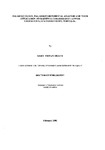PALAEOECOLOGY, PALAEOENVIRONMENTAL ANALYSIS AND THEIR APPLICATION TO SEQUENCE STRATIGRAPHY: LOWER CRETACEOUS, LUSITANIAN BASIN, PORTUGAL
| dc.contributor.author | AILLUD, GARY STEFAN | |
| dc.contributor.other | Faculty of Science and Engineering | en_US |
| dc.date.accessioned | 2013-10-09T09:45:22Z | |
| dc.date.available | 2013-10-09T09:45:22Z | |
| dc.date.issued | 2001 | |
| dc.identifier | NOT AVAILABLE | en_US |
| dc.identifier.uri | http://hdl.handle.net/10026.1/2102 | |
| dc.description.abstract |
Palaeoecological data can provide key information on depositional environments. This may be critical to the interpretation of marine sedimentary cycles and the recognition of ancient cycles and sequences. Although many recent studies have attempted to combine palaeoecology and sequence stratigraphy, the sequence stratigraphic model is commonly used to provide a temporally constrained framework for the evaluation of ecological and evolutionary events. This study shows how palaeoecology can be used as a powerful tool in the development of sequence stratigraphic models. A palaeoecological study of three Lower Cretaceous successions (at Ericeira, Cascais, Cabo Espichel) from the southern part of the Lusitanian Basin, Portugal, provides a basis for this study. This palaeoecological analysis allowed the construction of a detailed picture of the effects of relative sea-level, and other environmental factors, on sedimentary succession evolution. The results of this palaeoecological analysis have been represented on a series of depositional facies trend diagrams. The depositional facies diagrams have then been used to develop the sequence stratigraphy of the southern part of the Lusitanian Basin. The study successions record the temporal changes, and along-strike variation, in the evolution of three mixed carbonate-siliciclastic systems. The base of all the successions represents the development of narrow shelf with minor wave reworking. Siliciclastics were introduced by sand and gravel-load river dominated deltas with little reworking of the sediment at the channel mouths. This was characterised by the development of a clastic beach-barrier at Ericeira and a 'cool-water' carbonate ramp at Cascais. At Cabo Espichel a coral biostrome developed where coral ecology was controlled by terrigenous sedimentation and turbidity. The upper part of the successions represent a change in the morphology of the basin. A broad, shallow, low energy carbonate shelf developed that dissipated wave energy. In the nearshore environment siliciclastics were prevalent. The shelf carbonates are characteristic of the 'cool-water' type carbonates of the Cretaceous Tethyan realm. The more proximal Ericeira and Cabo Espichel successions record the alternation between marginal marine siliciclastic and shallow-water marine carbonate environments. The Cascais succession is characterised by carbonate platforms with abundant coral and rudist bivalve faunas. Palaeoecological analysis and development of the depositional facies trend diagrams have allowed the identification of one mega-sequence (2nd order), six sequences (3rd order) and higher resolution sequences and parasequences (4th order). 2nd and 3rd order sequences are correlatable across the southern part of the Lusitanian Basin. They also correlate with previously published sequence chronostratigraphy for the Tethyan realm. The palaeoecological analysis indicates that 2nd and 3rd order sequences are controlled by allocyclic processes and that 4th order cycles (sequences and parasequences) were dominated by autocyclic processes. As a result 4th order cycles cannot be correlated across the basin. This study has shown that detailed palaeoecological analysis can reveal a detailed, and more accurate, picture of the controls on the development of a basin fill than sedimentology alone. Along with the depositional trend diagrams, these data can provide a powerful method for the development of a sequence stratigraphic model and aid to interpretation of a basin fill. | en_US |
| dc.language.iso | en | en_US |
| dc.publisher | University of Plymouth | en_US |
| dc.title | PALAEOECOLOGY, PALAEOENVIRONMENTAL ANALYSIS AND THEIR APPLICATION TO SEQUENCE STRATIGRAPHY: LOWER CRETACEOUS, LUSITANIAN BASIN, PORTUGAL | en_US |
| dc.type | Thesis | |
| plymouth.version | Full version | en_US |
| dc.identifier.doi | http://dx.doi.org/10.24382/4004 |
Files in this item
This item appears in the following Collection(s)
-
01 Research Theses Main Collection
Research Theses Main


